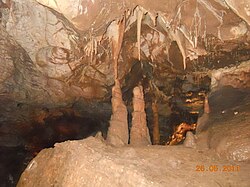Gadime e Ulët (Albanian: Gadime e Ulët, Serbian Cyrillic: Доње Гадимље/Donje Gadimlje) is a village in Lipjan municipality. Gadime e Ulët is located approximately 20 kilometers south of Prishtina and around seven kilometers southeast of Lipjan in the southern area of the Kosovo Polje. It is nestled against hills that border the eastern plain. A narrow passage between two hills leads eastward to the other side of the village, Gadime e Epërme.
Gadime e Ulët
| |
|---|---|
Village | |
 Gadime Village | |
| Coordinates: 42°28′36″N 21°12′20″E / 42.476741°N 21.205518°E | |
| Location | |
| District | Prishtinë |
| Municipality | Lipjan |
| Population (2011)[1] | |
| • Total | 3,337 |
| Time zone | UTC+1 (CET) |
| • Summer (DST) | UTC+2 (CEST) |
Gadime during the Kosovo War
editDuring the early days of NATO airstrikes, Gadime e Ulët endured shelling from Babus. A resident, interviewed by Human Rights Watch, recounted the influx of people from Crnilo (Cernille), a village near Muhadzer Babus, arriving "five or six days after NATO started bombing." The constant threat persisted as Serbian forces, with tanks, entered Donje Gadimlje around noon on April 1. The villagers, initially reassured the forces sought shelter, fled to a nearby river, but returned later the same day. However, they fled again at 5:00 p.m. when the Serbian army arrived with five tanks, reportedly firing into the air.[2]
Cultural Heritage and Genetics
editThe village of Gadime is home to a closely-knit community whose members all belong to the esteemed Albanian tribe known as Krasniqi. This tribe holds a significant place in the region's cultural fabric, with its roots tracing back through generations.[3][4] The individuals comprising the Krasniq tribe bear the distinctive genetic marker known as haplogroup J2b-L283. This genetic lineage serves as a notable identifier and connects the members of the Krasniq tribe through their ancestry. By tracing the presence of haplogroup J2b-L283 within the Krasniq tribe, we gain valuable insights into their genetic heritage and ancestral connections.[5][6]
References
edit- ^ 2011 Kosovo Census results
- ^ Abrahams, Fred (2001). Under Orders. Human Rights Watch. ISBN 978-1-56432-264-7.
- ^ Krasniqi, Mark (1984). Lugu i Baranit: monografi etno-gjeografike (in Albanian). Akademia e shkencave dhe e arteve e Kosovës.
- ^ Gjurmime albanologjike: Folklor dhe etnologji (in Albanian). Instituti Albanologijik i Prishtinës. 1982.
- ^ "Krasniqja & Nikaj – Rrënjët". Retrieved 2023-11-30.
- ^ http://asa.edu.al/site/ih/wp-content/uploads/sites/2/2022/06/Revista_Studime_historike_3-4-2021_2022_ME-LOGOBORD-75-96.pdf
